Throughout this interview we were happily regaled by seagulls calling across the garden.
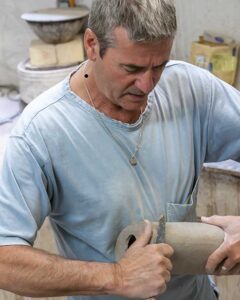
DG: Well, as you know John, I lived in St Ives in the old days. Over the years I’ve visited and I kept a low profile but the one thing that stuck in my consciousness as I often visited, is your shop by the Sloop; for one simple reason, it maintained excellent taste. I felt there was a very creative spirit there. As we all know St Ives has absolutely declined from the glory days. I’m very curious, how have you managed to maintain the quality that you did in your shop? With most people it would have gone by the board by now.
JB: I think it’s because I’m a maker and a potter and I understand good pots.
DG: …Yes you do.
JB: and I’m not really a gallery owner. It was almost accidental how it came about. My reason for buying and selling isn’t about making a profit, it’s about displaying.
DG: So you’re a craftsman/artist/collector?
JB: Yes. Well in fact, instead of having to collect pots and finding a place for them in my house, and you never can they always end up in the attic, I found I could go out and buy pots that I liked, meet the craftsmen, and then sell them on and not have to hold onto them and store them. So, I was collecting and getting all the enjoyment of collecting without all the down side of it.
DG: In today’s art world, which is international, very high-powered, and only millionaires seem to play if you watch the news about the auctions…
JB: … the auctions have gone crazy.
DG: Yes, but the point is it is ‘casino capitalism’ which is a trendy phrase. I get the feeling the object doesn’t mean anything anymore or it is just a calculation on the basis of fashion and this produces the dilemma we are in today, which is pretty tough.
JB: Are you saying that we are forgetting about the artistry and just looking at the bottom line and what will come into fashion?
DG: That is what I am saying.
JB: I know that I get asked, quite often, who shall I buy? Who will make me money in the future?
DG: Well, I won’t ask you that but I will ask you who’s interesting? (They both laugh) Obviously Leach was a very important part of your life, so let’s talk about that because I knew Leach a bit in the old days. I was too young to really understand him but I realised later that he was a profound thinker. And I have always loved his pots. His pots work for me. So, that embedded my taste. When did you first go to the Leach pottery?
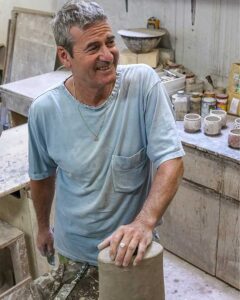
JB: 1968.
DG: And how long did you stay there?
JB: Well, there was a two-year apprenticeship, ‘student apprentice’ they called it. So, I stayed there two years and then I went to France to study under John Tessier for a year. I came back one Christmas and I went back to see Janet, and she asked me if I wanted to join the Leach staff. Which I just jumped at. I’d loved my two years there and I knew I still had a lot to learn. So I joined the Leach staff, and I was there for another six years until 1978.
DG: So you were at the Leach pottery for six years.
JB: Leach staff, yes.
DG: When did Bernard die?
JB: He died while I was in Japan in 1979.
DG: How long were you in Japan?
JB: I was in Japan for a year. I worked in an old pottery area called Tamba which is called Tachikui Ware. The eldest son came to the Leach pottery in 1970 and stayed for about 3½years.
DG: Who was that?
JB: Shigeyoshi Ichino. We got to be friends and I asked him when he left if I could come and work in his pottery. He was going back to take over the pottery because his father was getting too old, but he said it will be too complicated. So a few years later he came back to England and I asked him again. With Janet and Bernard’s approval I went.
DG: Why did you need their approval?
JB: I didn’t really need their approval but I was supposed to come back and work again at the Leach pottery. Also they helped me try to get some funding – which never happened.
DG: So, obviously Leach is a giant in a way, because he did so much and there are very few people that have the influence that Leach has had.
JB: Definitely in pottery yes. He was the father of studio pottery, really.

DG: I have often said that Leach to the craft world is like Picasso to the painting world.
JB: In influence yes. He has a lot of critics because I think really, he was dogmatic about how he saw things and wanted things, but by being like that he was able to create what he did create.
DG: How do you think we could sum up his contribution?
JB: Well one of his main contributions was that he trained potters. He trained, probably, over a hundred potters to a high standard in workshop practices. Those hundred potters went out, because they were international; they came from America, Australia, South Africa – and they went back to their countries and spread the word. So, it was like a domino effect of what was a good standard in ceramics.
DG: How would you characterize the essence of Leach in terms of what he taught and what he emphasized? How can we think about Leach’s values?
JB: He got his values from the East and the East had been making ceramics for thousands of years without a break. And high-temperature ceramics. The tradition in English ceramics was medieval which was all earthenware. So, he brought to England the ethics of the East but he was also an artist, as you know a graphic artist and a printmaker and a really skillful craftsman. He turned his talents into a really dynamic decorator of pots. He was the only person I know who could really look at a pot and know how to decorate it. You get Hamada, who had that skill of knowing how to decorate a pot, but he focused on just a few techniques. Whereas Bernard was always looking at how to translate the life around him, birds, the countryside, the cliffs – into decoration for pots. Now, some potters do that but they just paint on pots, whereas Bernard translated that imagery into design; really intricate fantastic designs and showed the skill with his hands of putting them onto a pot.
DG: What’s the difference between design and drawing on a pot?
JB: I suppose it’s the difference between abstract work and reality work, looking at something and just copying it. Whereas to design, you have to characterize something.
DG: I’ve always had a problem with the word design because I think of it as subsequent to machinery in the 20th century. If somebody talks about an Old Master for example Michelangelo, if they said he was a good designer that slightly worries me. That’s my problem with the word design but I do appreciate that Leach, in terms of an artist, brought something from the art world to the ceramic world that was not there before.
JB: Exactly
DG: He did talk about medieval English potters and he had a great respect for them and he absorbed the fact that in a way they were also very graphic, in a way that he was graphic.
JB: Some of the Japanese respect his earthenware which he took from medieval pottery. They consider that, some of his best work, which is quite interesting really.
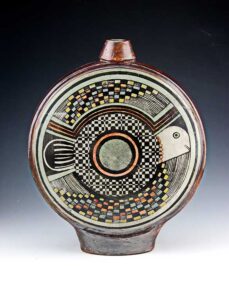
DG: Probably they saw it as being pure. So, this leads on to another very interesting topic, which is the craft / art debate. We all know that it’s been around for years and we all know it’s not resolved. But it’s an accident of history, an accident of Western history that somewhere down the line the word craft got into the vocabulary as opposed to art. Given your knowledge of Japan, would I be right in assuming that inside Japanese sensibility, they don’t quite distinguish between craft and art in the same way as the Westerners do?
JB: No they don’t. It’s all one.
DG: It’s all one. Fine. So, if I think of a Tea bowl I’m not going to categories that from my little knowledge of Japanese culture, because it obviously fits both prerogatives.
JB: Tea bowls are difficult to understand.
DG: Yes, they are very difficult to understand that they are neither craft not art, they are both. So that consciousness in a way must have permeated into Bernard Leach.
JB: I never had the debate with Bernard about craft/art.
DG: You never did? But he talked about it all the time.
JB: He did. He had an inner struggle with it really.
DG: What was the inner struggle?
JB: Well, he knew to survive he had to exhibit in art galleries and had to have hard prices on his pots. Whereas, his philosophy from Japan was about pots for the people, and the anonymous craftsman. Pots just sort of growing rather than being studied.
DG: Therefore if you can be logical, you should have high prices on pots?
JB: Of course yes, but you wouldn’t survive.
DG: That is the problem of survival. A potter today if he embraces that philosophy, probably isn’t going to be able to survive.
JB: He won’t know. That’s why they disappeared in the first place.
DG: So it was a hopeless ideal given the nature of our capitalist society. But it’s not a hopeless ideal in the nature of Japanese society?
JB: No, because they look at objects and they pick out the exquisite. And they are quite willing to pay huge prices.
DG: Because they can make up their minds about what is exquisite, I don’t think we can in the West.
JB: No we have to have our minds made up for us.
DG: Right. Well let’s just conclude this. Can you just talk about the nature of the opposition to Leach? Why is there a whole school of anti-Leach?
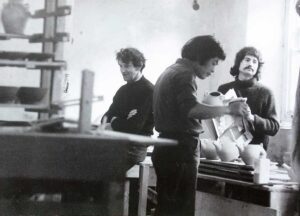
JB: I think it’s a natural thing in the art world and many worlds, seeing someone that has a lot of influence especially if you want influence; to knock the person who has the influence. Leach had a huge influence while he was alive. Then you get the places like the Royal School of Art, the Royal College who promote pots as art. They are specifically made as art objects. They are not trying to make objects to be used they are specifically made for the art world. They saw Leach, his colours were a bit subdued, his pots were too restrictive because they were pots.
DG: I think they were called round and brown?
JB: Yes, exactly. And it went against their whole sort of philosophy, so they just wanted to get rid of his influence and impose their influence.
DG: If you have an avant-garde culture, which assumes there is a particular form for a particular time, which is dialectical materialism in a way. That culture is unique in its time and therefore there has to be a form that matches that. This is why we have the “isms” of modern art. And it’s got progressively worse since the avant-garde was Americanized. Inside the Leach tradition in theory, you can have something traditional that is sensitive to the time and can be both traditional and alert to the contemporary world?
JB: Yes, but it’s a clever trick to do. It is not an easy ask.
DG: May we perhaps talk about St Ives a little bit. I remember the story about two Japanese guys who came to St Ives assumed there would be a Leach pot on exhibit but couldn’t find one. The local media got hold of this. By this time there was the St Ives Tate but I think you have something to say about this because the Tate originally said there was always going to be Leach pots on display?
JB: Yes they did. The Tate came to the town to represent the artists of the 50s, the Modernists. And they included Bernard Leach in their group. The first director Mike Tooby said if you’re going to exhibit the Modernists you have to exhibit Bernard Leach. They had a specific cabinet built for Leach pots not just Leach but also his contemporaries which is the circular showcase. When Mike Tooby left Susan Daniel McElroy who had no understanding of pottery and didn’t like it took over and decided it was no longer going to be in the place.
DG: So that tradition became defunct?
JB: Became defunct? Well they seem to warm to the idea of having a few pots in there nowadays
DG: So it’s reversing a bit?
JB: Yes it is slowly reversing
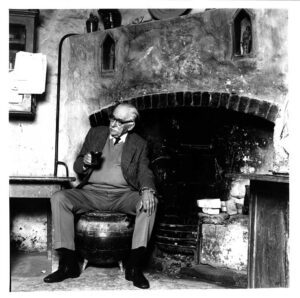
DG: It strikes me that Tooby in the early days of the Tate was more alert in a number of ways. This is only one way in which he was more alert and that kind of disappeared as successive directors appeared, would you agree?
JB: I think Tooby adhered to the original brief for the Tate more than the others
DG: And of course the original brief was in part organised by Alan Burness.
JB: Yes, I suppose.
DG: Well he was the director of the Tate and the son-in-law of Hepworth and Nicholson.
JB:Yes.
DG: I think we can leave it there.
Volume 33.no.1 September / October 2018 pp 16 -19
